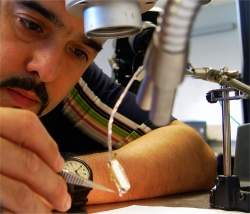 |
| Segundo os pesquisadores, essa redução da Medicina à Economia vai afastar profissionais realmente focados no humanismo, transformando os profissionais da saúde em burocratas seguidores de regras pré-estabelecidas para darem maior lucro. |
Em uma denúncia contundente e alarmante, dois médicos britânicos alertam que a Medicina está sendo reduzida às questões econômicas.
Os médicos, que antes precisavam aprender apenas a linguagem médica, agora devem também lidar com um mundo da saúde que transformou hospitais em fábricas e consultas médicas em transações econômicas.
"Os pacientes não são mais pacientes, são 'consumidores' ou 'clientes'. Os médicos e enfermeiros foram transformados em 'fornecedores'," afirmam Pamela Hartzband e Jerome Groopman em um artigo no conceituadoNew England Journal of Medicine.
Soluções de prateleira
Segundo os estudiosos, as reformas dos sistemas de saúde que estão ocorrendo no mundo todo estão permitindo que economistas e políticos estabeleçam que os cuidados aos pacientes devam ser "industrializados e padronizados".
"Os hospitais e clínicas devem funcionar como fábricas, e termos arcaicos, como doutor, enfermeira e paciente devem ser assim substituídos por uma terminologia mais adequada a essa nova ordem," escrevem eles.
O problema, segundo os autores, é que o conhecimento especializado que os médicos e enfermeiras têm e usam para ajudar os pacientes a entenderem as razões de duas doenças e os tratamentos disponíveis está se perdendo em um sistema em que tudo deve depender de "soluções de prateleira", que pretendem substituir a "prática baseada em evidências" pelo "julgamento clínico".
Curandeirismo moderno
"Reduzir a medicina à economia faz uma paródia do vínculo entre o curandeiro e os doentes," escrevem os pesquisadores.
"Por séculos, os médicos mercenários têm sido publicamente e devidamente castigados. Esses médicos traem seu juramento. Devemos nós agora elogiar o médico cuja prática, como um negócio bem-sucedido, maximiza os lucros obtidos de seus 'clientes'?" questionam eles.
Nesse novo mundo da "Medicina Econômica", economistas e políticos querem que a prática da Medicina se reduza a seguir alguns manuais de instruções contendo orientações pré-estabelecidas.
Mas essas orientações, argumentam os estudiosos, são preferências subjetivas escolhidas por quem elabora as normas, e não conclusões científicas.
Normas subjetivas
Eles citam como exemplo o fato de que diferentes grupos de especialistas traçam guias de orientação diferentes partindo dos mesmos dados e dos mesmos experimentos científicos.
E isso em questões que vão dos cuidados com a hipertensão e o colesterol alto até os exames preventivos para câncer de próstata e câncer de mama.
Nos casos dos cânceres de mama e próstata, por exemplo, inúmeros estudos afirmam que o rastreamento não produz os benefícios apregoados, mas as organizações médicas orientam exames cada vez mais precoces.
Quando são colocados para debater, a discussão dá razão aos dois estudiosos, acabando em questões econômicas: os defensores de uma posição dizem que os outros querem ganhar dinheiro com mais exames, enquanto os defensores da outra posição dizem que o outro lado quer economizar dinheiro para os planos de saúde.
E os estudos científicos são deixados de lado.
Usurários da Medicina
Mais problemática ainda, afirmam os dois estudiosos, é o impacto do novo vocabulário sobre os futuros médicos, enfermeiros, terapeutas e assistentes sociais.
"Quando nós mesmos ficamos doentes, nós queremos alguém cuidando de nós como pessoas, não como clientes que estão pagando, e para individualizar nosso tratamento de acordo com nossos valores," escrevem eles.
Segundo os pesquisadores, essa redução da Medicina à Economia vai afastar profissionais realmente focados no humanismo, transformando os profissionais da saúde em burocratas seguidores de regras pré-estabelecidas para darem maior lucro.




